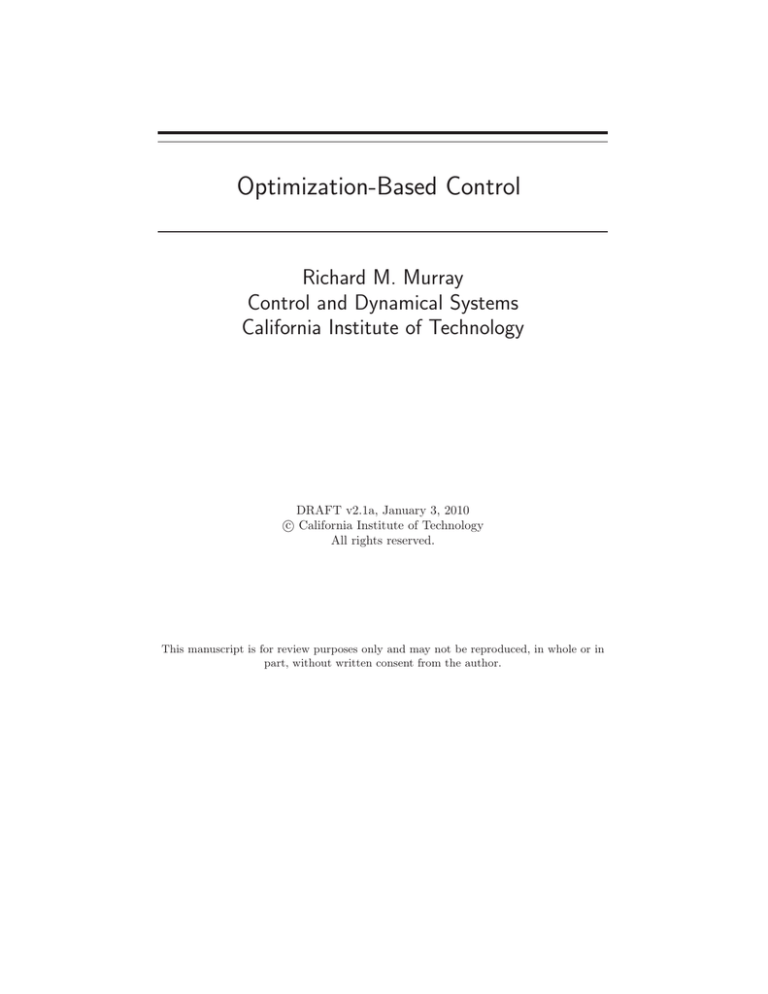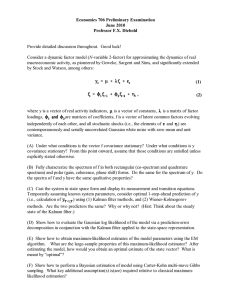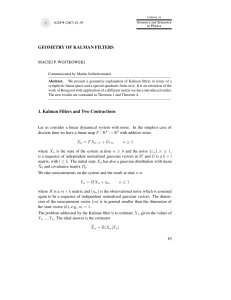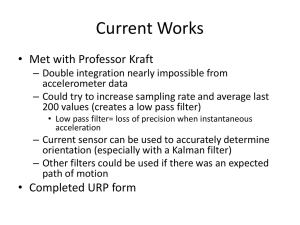
Optimization-Based Control
Richard M. Murray
Control and Dynamical Systems
California Institute of Technology
DRAFT v2.1a, January 3, 2010
c California Institute of Technology
All rights reserved.
This manuscript is for review purposes only and may not be reproduced, in whole or in
part, without written consent from the author.
Chapter 5
Kalman Filtering
In this chapter we derive the optimal estimator for a linear system in continuous
time (also referred to as the Kalman-Bucy filter). This estimator minimizes the
covariance and can be implemented as a recursive filter.
Prerequisites. Readers should have basic familiarity with continuous-time stochastic
systems at the level presented in Chapter ??.
5.1
Linear Quadratic Estimators
Consider a stochastic system
Ẋ = AX + Bu + F W,
Y
= CX + V,
where X represents that state, u is the (deterministic) input, W represents disturbances that affect the dynamics of the system and V represents measurement noise.
Assume that the disturbance W and noise V are zero-mean, Gaussian white noise
(but not necessarily stationary):
1 T −1
1
e− 2 w RW w
p(w) = √
√
n
2π det RW
1 T −1
1
e− 2 v Rv v
p(v) = √
√
n
2π det Rv
E{W (s)W T (t)} = RW (t)δ(t − s)
E{V (s)V T (t)} = Rv (t)δ(t − s)
We also assume that the cross correlation between W and V is zero, so that the
disturbances are not correlated with the noise. Note that we use multi-variable
Gaussians here, with noise intensities RW ∈ Rm×m and RV ∈ Rp×p . In the scalar
2
case, RW = σW
and RV = σV2 .
We formulate the optimal estimation problem as finding the estimate X̂(t) that
minimizes the mean square error E{(X(t) − X̂(t))(X(t) − X̂(t))T } given {Y (τ ) :
0 ≤ τ ≤ t}. It can be shown that this is equivalent to finding the expected value of
X subject to the “constraint” given by all of the previous measurements, so that
X̂(t) = E{X(t)|Y (τ ), τ ≤ t}. This was the way that Kalman originally formulated
the problem and it can be viewed as solving a least squares problem: given all
previous Y (t), find the estimate X̂ that satisfies the dynamics and minimizes the
square error with the measured data. We omit the proof since we will work directly
with the error formulation.
Theorem 5.1 (Kalman-Bucy, 1961). The optimal estimator has the form of a
linear observer
˙
X̂ = AX̂ + BU + L(Y − C X̂)
5-2
5.1. LINEAR QUADRATIC ESTIMATORS
where L(t) = P (t)C T Rv−1 and P (t) = E{(X(t) − X̂(t))(X(t) − X̂(t))T } satisfies
Ṗ = AP + P AT − P C T Rv−1 (t)CP + F RW (t)F T ,
P (0) = E{X(0)X T (0)}.
Sketch of proof. The error dynamics are given by
Ė = (A − LC)E + ξ,
ξ = F W − LV,
Rξ = F RW F T + LRv LT
The covariance matrix PE = P for this process satisfies
Ṗ = (A − LC)P + P (A − LC)T + F RW F T + LRv LT
= AP + P AT + F RW F T − LCP − P C T LT + LRv LT
= AP + P AT + F RW F T + (LRv − P C T )Rv−1 (LRv + P C T )T
− P C T Rv CP,
where the last line follows by completing the square. We need to find L such that
P (t) is as small as possible, which can be done by choosing L so that Ṗ decreases
by the maximum amount possible at each instant in time. This is accomplished by
setting
LRv = P C T
=⇒
L = P C T Rv−1 .
Note that the Kalman filter has the form of a recursive filter: given P (t) =
E{E(t)E T (t)} at time t, can compute how the estimate and covariance change.
Thus we do not need to keep track of old values of the output. Furthermore, the
Kalman filter gives the estimate X̂(t) and the covariance PE (t), so you can see how
well the error is converging.
If the noise is stationary (RW , RV constant) and if the dynamics for P (t) are
stable, then the observer gain converges to a constant and satisfies the algebraic
Riccati equation:
L = P C T Rv−1
AP + P AT − P C T Rv−1 CP + F RW F T .
This is the most commonly used form of the controller since it gives an explicit
formula for the estimator gains that minimize the error covariance. The gain matrix
for this case can solved use the lqe command in MATLAB.
Another property of the Kalman filter is that it extracts the maximum possible
information about output data. To see this, consider the residual random process
R = Y − C X̂
(this process is also called the innovations process). It can be shown for the Kalman
filter that the correlation matrix of R is given by
RR (t, s) = W (t)δ(t − s).
This implies that the residuals are a white noise process and so the output error
has no remaining dynamic information content.
5-3
5.2. EXTENSIONS OF THE KALMAN FILTER
5.2
Extensions of the Kalman Filter
Correlated disturbances and noise
The derivation of the Kalman filter assumes that the disturbances and noise are independent and white. Removing the assumption of independence is straightforward
and simply results in a cross term (E{W (t)V (s)} = RW V δ(s − t)) being carried
through all calculations.
To remove the assumption of white noise disturbances, we can construct a filter
that takes white noise as an input and produces a disturbance source with the
appropriate correlation function (or equivalently, spectral power density function).
The intuition behind this approach is that we must have an internal model of
the noise and/or disturbances in order to capture the correlation between different
times.
Eliminating correlated sensor noise is more difficult.
Extended Kalman filters
Consider a nonlinear system
Ẋ = f (X, U, W ),
Y = CX + V,
X ∈ Rn , u ∈ Rm ,
Y ∈ Rp ,
where W and V are Gaussian white noise processes with covariance matrices RW
and RV . A nonlinear observer for the system can be constructed by using the
process
˙
X̂ = f (X̂, U, 0) + L(Y − C X̂).
If we define the error as E = X − X̂, the error dynamics are given by
Ė = f (X, U, W ) − f (X̂, U, 0) − LC(X − X̂)
= F (E, X̂, U, W ) − LCe
where
F (E, X̂, U, W ) = f (E + X̂, U, W ) − f (X̂, U, 0)
We can now linearize around current estimate X̂:
Ê =
∂F
∂F
E + F (0, X̂, U, 0) +
W−
∂E
∂W
|
{z
} | {z }
=0
noise
≈ ÃE + F̃ W − LCE,
where the matrices
∂F Ã =
∂e (0,X̂,U,0)
∂F F̃ =
∂W (0,X̂,U,0)
LCe
|{z}
obserwer gain
∂f =
∂X (X̂,U,0)
∂f =
∂W (X̂,U,0)
+
h.o.t
5-4
5.3. LQG CONTROL
depend on current estimate X̂. We can now design an observer for the linearized
system around the current estimate:
˙
X̂ = f (X̂, U, 0) + L(Y − C X̂),
L = P C T Rv−1 ,
Ṗ = (Ã − LC)P + P (Ã − LC)T + F̃ RW F̃ T + LRv LT ,
P (t0 ) = E{X(t0 )X T (t0 )}
This is called the (Schmidt) extended Kalman filter (EKF).
The intuition in the Kalman filter is that we replace the prediction portion of
the filter with the nonlinear modeling while using the instantaneous linearization
to compute the observer gain. Although we lose optimality, in applications the
extended Kalman filter works very well and it is very versatile, as illustrated in the
following example.
Example 5.1 Online parameter estimation
Consider a linear system with unknown parameters ξ
Ẋ = A(ξ)X + B(ξ)U + F W,
Y = C(ξ)X + V.
ξ ∈ Rp ,
We wish to solve the parameter identification problem: given U (t) and Y (t), estimate the value of the parameters ξ.
One approach to this online parameter estimation problem is to treat ξ as an
unknown state that has zero derivative:
Ẋ = A(ξ)X + B(ξ)U + F W,
ξ˙ = 0.
We can now write the dynamics in terms of the extended state Z = (X, ξ):
h i
f( X
ξ ,U,W )
z
d X
A(ξ)
=
0
dt ξ
{ }| F
B(ξ)
0 X
W,
U+
+
0
0
0 ξ
Y = C(ξ)X + V .
|
{z
}
h i
h( X
ξ ,W )
This system is nonlinear in the extended state Z, but we can use the extended
Kalman filter to estimate Z. If this filter converges, then we obtain both an estimate
of the original state X and an estimate of the unknown parameter ξ ∈ Rp .
Remark: need various observability conditions on augmented system in order
for this to work.
∇
5.3
LQG Control
Return to the original “H2 ” control problem
Figure
Ẋ = AX + BU + F W
Y = CX + V
W, V Gaussian white
noise with covariance
RW , RV
5.4. APPLICATION TO A THRUST VECTORED AIRCRAFT
5-5
Stochastic control problem: find C(s) to minimize
Z ∞
J =E
(Y − r)T RW (Y − r)T + U T Rv U dt
0
Assume for simplicity that the reference input r = 0 (otherwise, translate the state
accordingly).
Theorem 5.2 (Separation principle). The optimal controller has the form
˙
X̂ = AX̂ + BU + L(Y − C X̂)
U = K(X̂ − Xd )
where L is the optimal observer gain ignoring the controller and K is the optimal
controller gain ignoring the noise.
This is called the separation principle (for H2 control).
5.4
Application to a Thrust Vectored Aircraft
To illustrate the use of the Kalman filter, we consider the problem of estimating
the state for the Caltech ducted fan, described already in Section ??.
The following code implements an extended Kalman filter in MATLAB, by
constructing a state vector that consists of the actual state, the estimated state
and the elements of the covariance matrix P (t):
%
%
%
%
%
%
%
%
%
%
%
%
pvtol.m - nonlinear PVTOL model, with LQR and EKF
RMM, 5 Feb 06
This function has the dynamics for a nonlinear planar vertical takeoff
and landing aircraft, with an LQR compensator and EKF estimator.
state(1) x position, in meters
state(2) y position, in meters
state(3) theta angle, in radians
state(4-6) velocities
state(7-12) estimated states
state(13-48) covariance matrix (ordered rowise)
function deriv = pvtol(t, state, flags)
global pvtol_K; % LQR gain
global pvtol_L; % LQE gain (temporary)
global pvtol_Rv; % Disturbance covariance
global pvtol_Rw; % Noise covariance
global pvtol_C; % outputs to use
global pvtol_F; % disturbance input
% System parameters
J = 0.0475; % inertia around pitch axis
m = 1.5; % mass of fan
5.4. APPLICATION TO A THRUST VECTORED AIRCRAFT
5-6
r = 0.25; % distance to flaps
g = 10; % gravitational constant
d = 0.2;
% damping factor (estimated)
% Initialize the derivative so that it is correct size and shape
deriv = zeros(size(state));
% Extract the current state estimate
x = state(1:6);
xhat = state(7:12);
% Get the current output, with noise
y = pvtol_C*x + pvtol_C * ...
[0.1*sin(2.1*t); 0.1*sin(3.2*t); 0; 0; 0; 0];
% Compute the disturbance forces
fd = [
0.01*sin(0.1*t); 0.01*cos(0.027*t); 0
];
% Compute the control law
F = -pvtol_K * xhat + [0; m*g];
% A matrix at current estimated state
A = [ 0
0
0
1
0
0;
0
0
0
0
1
0;
0
0
0
0
0
1;
0, 0, (-F(1)*sin(xhat(3)) - F(2)*cos(xhat(3)))/m, -d, 0, 0;
0, 0, (F(1)*cos(xhat(3)) - F(2)*sin(xhat(3)))/m, 0, -d, 0;
0
0
0
0
0
0 ];
% Estimator dynamics (prediction)
deriv(7) = xhat(4); deriv(8) = xhat(5); deriv(9) = xhat(6);
deriv(10) = (F(1) * cos(xhat(3)) - F(2) * sin(xhat(3)) - d*xhat(4)) / m;
deriv(11) = (F(1) * sin(xhat(3)) + F(2) * cos(xhat(3)) - m*g - d*xhat(5)) / m;
deriv(12) = (F(1) * r) / J;
% Compute the covariance
P = reshape(state(13:48), 6, 6);
dP = A * P + P * A’ - P * pvtol_C’ * inv(pvtol_Rw) * pvtol_C * P + ...
pvtol_F * pvtol_Rv * pvtol_F’;
L = P * pvtol_C’ * inv(pvtol_Rw);
% Now compute correction
xcor = L * (y - pvtol_C*xhat);
for i = 1:6, deriv(6+i) = deriv(6+i) + xcor(i); end;
% PVTOL dynamics
deriv(1) = x(4); deriv(2) = x(5); deriv(3) = x(6);
deriv(4) = (F(1)*cos(x(3)) - F(2)*sin(x(3)) - d*x(4) + fd(1)) / m;
deriv(5) = (F(1)*sin(x(3)) + F(2)*cos(x(3)) - m*g - d*x(5) + fd(2)) / m;
deriv(6) = (F(1) * r + fd(3)) / J;
5.4. APPLICATION TO A THRUST VECTORED AIRCRAFT
5-7
% Copy in the covariance updates
for i = 1:6,
for j = 1:6,
deriv(6+6*i+j) = dP(i, j);
end;
end;
% All done
return;
To show how this estimator can be used, consider the problem of stabilizing the
system to the origin with an LQR controller that uses the estimated state. The
following MATLAB code implements the controller, using the previous simulation:
% kf_dfan.m - Kalman filter for the ducted fan
% RMM, 5 Feb 06
% Global variables to talk to simulation modle
global pvtol_K pvtol_L pvtol_C pvtol_Rv pvtol_Rw pvtol_F;
%%
%% Ducted fan dynamics
%%
%% These are the dynamics for the ducted fan, written in state space
%% form.
%%
%
J
m
r
g
d
System parameters
= 0.0475; % inertia around pitch axis
= 1.5; % mass of fan
= 0.25; % distance to flaps
= 10; % gravitational constant
= 0.2;
% damping factor (estimated)
% System matrices (entire plant: 2 input, 2 output)
A = [ 0
0
0
1
0
0;
0
0
0
0
1
0;
0
0
0
0
0
1;
0
0
-g
-d/m
0
0;
0
0
0
0
-d/m
0;
0
0
0
0
0
0 ];
B = [
C = [
0
0
0
1/m
0
r/J
0;
0;
0;
0;
1/m;
0
];
1
0
0
1
0
0
0
0
0
0
0;
0 ];
5.4. APPLICATION TO A THRUST VECTORED AIRCRAFT
D = [
0
0;
0
0];
dfsys = ss(A, B, C, D);
%%
%% State space control design
%%
%% We use an LQR design to choose the state feedback gains
%%
K = lqr(A, B, eye(size(A)), 0.01*eye(size(B’*B)));
pvtol_K = K;
%%
%% Estimator #1
%%
% Set the disturbances and initial condition
pvtol_F = eye(6);
pvtol_Rv = diag([0.0001, 0.0001, 0.0001, 0.01, 0.04, 0.0001]);
x0 = [0.1 0.2 0 0 0 0];
R11 = 0.1; R22 = 0.1; R33 = 0.001;
% Set the weighting matrices (L is computed but not used)
pvtol_C = [1 0 0 0 0 0; 0 1 0 0 0 0];
pvtol_Rw = diag([R11 R22]);
pvtol_L = lqe(A, pvtol_F, pvtol_C, pvtol_Rv, pvtol_Rw);
[t1, y1] = ode45(@pvtol, [0, 15], ...
[x0 0*x0 reshape(x0’*x0, 1, 36)]);
subplot(321);
plot(t1, y1(:,1), ’b-’, t1, y1(:,2), ’g--’);
legend x y;
xlabel(’time’);
ylabel(’States (no \theta)’);
axis([0 15 -0.3 0.3]);
subplot(323);
plot(t1, y1(:,7) - y1(:,1), ’b-’, ...
t1, y1(:,8) - y1(:,2), ’g--’, ...
t1, y1(:,9) - y1(:,3), ’r-’);
legend xerr yerr terr;
xlabel(’time’);
ylabel(’Errors (no \theta)’);
axis([0 15 -0.2 0.2]);
subplot(325);
plot(t1, y1(:,13), ’b-’, t1, y1(:,19), ’g--’, t1, y1(:,25), ’r-’);
legend P11 P22 P33
xlabel(’time’);
5-8
5.5. FURTHER READING
5-9
ylabel(’Covariance (w/ \theta)’);
axis([0 15 -0.2 0.2]);
%%
%% Estimator #2
%%
% Now change the output and see what happens (L computed but not used)
pvtol_C = [1 0 0 0 0 0; 0 1 0 0 0 0; 0 0 1 0 0 0];
pvtol_Rw = diag([R11 R22 R33]);
pvtol_L = lqe(A, pvtol_F, pvtol_C, pvtol_Rv, pvtol_Rw);
[t2, y2] = ode45(@pvtol, [0, 15], ...
[x0 0*x0 reshape(x0’*x0, 1, 36)]);
subplot(322);
plot(t2, y2(:,1), ’b-’, t2, y2(:,2), ’g--’);
legend x y;
xlabel(’time’);
ylabel(’States (w/ \theta)’);
axis([0 15 -0.3 0.3]);
subplot(324);
plot(t2, y2(:,7) - y2(:,1), ’b-’, ...
t2, y2(:,8) - y2(:,2), ’g--’, ...
t2, y2(:,9) - y2(:,3), ’r-’);
legend xerr yerr terr;
xlabel(’time’);
ylabel(’Errors (w/ \theta)’);
axis([0 15 -0.2 0.2]);
subplot(326);
plot(t2, y2(:,13), ’b-’, t2, y2(:,19), ’g--’, t2, y2(:,25), ’r-’);
legend P11 P22 P33
xlabel(’time’);
ylabel(’Covariance (w/ \theta)’);
axis([0 15 -0.2 0.2]);
print -dpdf dfan_kf.pdf
5.5
Further Reading
Exercises
5.1 Consider the problem of estimating the position of an autonomous mobile
vehicle using a GPS receiver and an IMU (inertial measurement unit). The dynamics
of the vehicle are given by
B-1
5.5. FURTHER READING
φ
y
l
θ
ẋ = cos θ v
ẏ = sin θ v
1
θ̇ = tan φ v,
ℓ
x
We assume that the vehicle is disturbance free, but that we have noisy measurements from the GPS receiver and IMU and an initial condition error.
In this problem we will utilize the full form of the Kalman filter (including the
Ṗ equation).
(a) Suppose first that we only have the GPS measurements for the xy position of
the vehicle. These measurements give the position of the vehicle with approximately
1 meter accuracy. Model the GPS error as Gaussian white noise with σ = 1.2 meter
in each direction and design an optimal estimator for the system. Plot the estimated
states and the covariances for each state starting with an initial condition of 5 degree
heading error at 10 meters/sec forward speed (i.e., choose x(0) = (0, 0, 5π/180) and
x̂ = (0, 0, 0)).
(b) An IMU can be used to measure angular rates and linear acceleration. Assume
that we use a Northrop Grumman LN200 to measure the angular rate θ̇. Use the
datasheet on the course web page to determine a model for the noise process and
design a Kalman filter that fuses the GPS and IMU to determine the position of
the vehicle. Plot the estimated states and the covariances for each state starting
with an initial condition of 5 degree heading error at 10 meters/sec forward speed.
Note: be careful with units on this problem!





